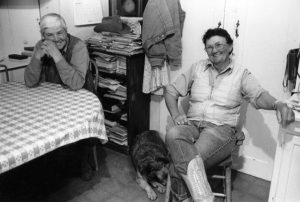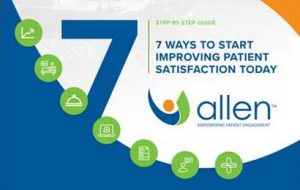
Living and Ranching in New Mexico: Special Place, Special People
The news looks scary for the historic northeastern New Mexico town of Cimarron and surrounding community. When I heard this week that once again, wildfires are threatening homes, property and lives around Cimarron and the Philmont Boy Scout Camp, my first thought was of my visit to Chase Ranch 15 years ago – just after another devastating fire had scorched 100,000 acres there, including 5,000 on the Chase Ranch. In May 2003, I had the great honor to travel to the ranch to interview its then-owner Gretchen Sammis, a Cowgirl Hall of Fame recipient and fourth-generation ranch owner, and Ruby Gobble, trick rider, champion roper and then-ranch manager. They were tough, no-nonsense, funny, smart business women who graciously welcomed Keith and me into their home and proudly toured us over back country roads to show us the beauty of this land – and the power of wildfire. Since Sammis’ death in 2012 and Gobble’s in 2013, the ranch has been preserved as an historic working ranch and museum operated by the adjoining Philmont Ranch. Here’s their story from my trip that spring, which ran in Landscapes magazine in the fall of 2003.
It is late April and the last of the James Coppedge’s hunters are headed home, another hunting season complete. Even the wildlife seem to have put out an all-clear signal, as turkey carelessly meander through Chase Ranch owner Gretchen Sammis’ orchard, seemingly oblivious to the humans nearby.
From early fall through late April, the historic Chase Ranch just north of Cimarron, New Mexico, serves as home base for Coppedge’s Pack-n-Horns Outfitter Service. The rest of the year, it is home only to Sammis, ranch foreman Ruby Gobble, their dogs and cowherd – and multitudes of elk, deer, and other native wildlife.
For hunters who sign on for one of Pack-n-Horns’ guided elk, deer, turkey or bear hunts at the Chase, the experience is about a lot more than just the thrill of the hunt. This is a piece of the American West, and the history lesson here can’t adequately be told in schoolbooks. It has to be experienced.
Hunting, History along the Santa Fe Trail
The town of Cimarron isn’t much different than it was when Sammis’ great-grandparents Manly and Theresa Chase first arrived here in the late 1860s with their wagon loaded down, ready to start a new life. “The railroad came, and has now gone. The town moved from one side of the Cimarron River to the other, and when the railroad was abandoned, the town took up a business district along a new highway. But a lot of the old town is still here — the very buildings that the Chases and their friends visited are in use today,” wrote rancher Richard K. Wooten in his forward to the biography, “The Chases of Cimarron.”
Indeed, a drive into Cimarron is like stepping into an Old West movie set. Ranchers and outfitters drop by the St. James Hotel for dinner and music on the occasional Sunday evening, their dogs in tow. The hotel’s hallway is lined with photos and memorabilia of guests who slept in these rooms – legends like Wyatt Earp and Billy the Kid. Land grant baron Lucien Maxwell made his headquarters in Cimarron, where the old jail and 1872 courthouse still stand. Kit Carson lived in a cabin near the Chase homestead. And according to Albuquerque journalist Sharon Niederman, Lew Wallace finished writing his classic “Ben Hur” under the apple trees in the Chase orchard.
A 136-Year Ranching Legacy
Manly and Theresa Chase settled in the Chase Canyon in 1867, purchasing 1,000 acres of what once was part of the Maxwell Land Grant along the Ponil River from Lucien Maxwell. The ranch eventually grew to encompass 11,000 acres along the eastern slope of the Sangre de Cristo mountains.
Gretchen Sammis grew up on the ranch, raised by her grandparents Stanley and Zeta Chase. She still lives in the 130-year-old adobe home her great-grandparents built, still sleeps in the bed in which she was born. The house was expanded over time from its original four rooms to include a larger dining room, office, more bedrooms and a second story – built by her great-grandmother and ranch hands while Manly was on a cattle-buying trip in Texas.
Sammis took over management of the Chase in 1954, running everything from the dairy to the stables and Herefords. “The 1950s were a tough time for the dairy business,” recalls Sammis, an Ag New Mexico Farm Credit customer for more than 40 years. To supplement income, she used her degree from Colorado Women’s College and master’s from the University of Colorado to teach physical education and science at Cimarron High School. The dairy eventually closed, but Sammis avoided selling the ranch.
Hunting Lease Aids Ranch Cash Flow
Her resourcefulness was put to the test again three decades later. “The early 1980s were just plain bad for ranching,” she says. “We needed to generate more income from another source.” A colleague on the University of New Mexico Alumni Executive Committee suggested leasing to a hunting outfitter, a common practice in a state where more than $1 billion is spent annually on wildlife recreation, according to the New Mexico Department of Fish and Game.
Its annual survey found 130,000 hunters took advantage of New Mexico’s game hunting in 2001, nearly 20 percent of those traveling from out of state. Big-game hunting is big business here, bringing in some $60 million annually. And many of those dollars are spent in Colfax County, where ranches like Ted Turner’s 588,000-acre Vermejo Park Ranch and the 137,000-acre Philmont Scout Ranch adjoin Gretchen Sammis’ property. Each fall, the airport at Raton is buzzing with corporate and private jets ferrying famous and not-so-famous to Colfax County’s prime hunting destinations.
Finding the Right Outfitter
Sammis heeded her friend’s advice, and has contracted her land to hunting outfitters ever since – though not always without problems. “I learned the hard way,” she says. “At first, I didn’t check them out like I should have, and I signed contracts that were drawn up by the outfitter’s attorney.” When the outfitter failed to pay utility bills and live up to other agreements, she had to sue to get him off the ranch.
Lesson learned, Sammis since has worked only with individuals she personally knows and trusts, and hires a local attorney to draw up the agreements. While some area ranchers lease directly to hunters, Sammis says contracting with an outfitter is the norm. “It’s just too labor intensive to do it yourself; this is the easiest way to go unless you have a lot of time on your hands and really like dealing with the public,” she says.
For the past six years, she has contracted with James Coppedge, who had been a guide for six years with the ranch’s previous outfitter. “I had no idea how hard it would be to go from being a guide, to being the outfitter,” Coppedge says. “The first few years were really stressful trying to book hunts, work with agents, do the marketing, the financials.”
At $5,000 for a five-day elk hunt, Coppedge knows his is a luxury business. “Most of my clients come from the northeast, places where they don’t have elk,” he says. “What brings people here is the opportunity to have a private hunt on private property.”
Many landowners require outfitters to pay the lease in full prior to season opening, but he and Sammis worked out a lease payment plan on a three-year agreement. Coppedge pays her a set amount, and in return gets the use of the house during hunting season. He is responsible for maintaining the facilities, paying utilities, carrying insurance, and notifying Sammis when hunters will be on the property.
Coppedge is one of hundreds of registered outfitters in New Mexico, who must pass a Game and Fish Department exam covering hunting regulations, wilderness survival, first aid, ethics, federal land use regulations and outdoorsmanship. Registered outfitters can have no felony convictions, must pass a hunter education course, carry a minimum of $500,000 commercial liability insurance and pay a $500 application fee.
Some landowners opt to hire non-registered outfitters, or hire an outfitter as an agent, but the experts say proceed with caution. An agent doesn’t have to be registered, but the landowner is liable for any accidents or breach of contract with hunters.
“A game warden will tell you a landowner is foolish not to hire a registered outfitter,” says Lief Ahlm, assistant chief for New Mexico Game and Fish Department’s Northeastern region. “It’s no different than hiring a plumber. You just don’t hire someone who’s not licensed. A lot of landowners don’t think about the consequences.”
If a landowner should opt to hire an agent, Ahlm recommends requiring them to become registered so they carry liability insurance and have a binding contract.
The Threat of Wildfires
Last June, Sammis faced yet another challenge to the ranch when lightening sparked the start of what became one of the largest wildfires in the U.S. The Ponil Fire scorched 100,000 acres, including more than 10,000 acres on the adjoining Vermejo and another 22,000-plus on the Philmont. The fires soon moved onto the Chase where they spread across some 5,000 acres. It took more than 1,300 firefighters 15 days to extinguish the fires.
The resulting ash was so thick that when rained finally arrived, the water coming down the Ponil River from the mountains upstream was black. “All our water for the cattle had to come from the windmill next to town, and we had to buy hay,” says Sammis.
In the past year, she has aerial seeded 500 acres to promote vegetation regrowth — not surprising for a rancher known for supporting ranching and conservation efforts. A long-time leader of New Mexico Soil and Water Conservation, she has served as director of the Colfax County Soil and Water Conservation District, as a director of the New Mexico Soil and Water Commission, and as chair of the National Association of Conservation District’s Grazing Lands and Public Lands Committee. In 1986, Sammis was a Western Heritage honoree in the National Cowgirl Hall of Fame. Her longtime friend and ranch foreman Ruby Gobble was inducted into the Cowgirl Hall of Fame in 1982.
Cattle Income Supplements the Hunting
The hunting business is only one part of the ranch operation, but an important one. Sammis and Gobble culled their Hereford herd by 58 after last summer’s wildfires. They currently have 143 older cows, 32 first-calf heifers and 27 replacement heifers. “Usually the cattle pay for themselves, and make a little,” she notes. “But the hunting is what pays the bills.”
That is a common story among New Mexico ranchers, according to Landon Newton, vice president of Ag New Mexico Farm Credit Services. He estimates that 75 percent of his Albuquerque office loan portfolio is ranching loans.
“The majority of our customers have some type of hunting income,” he says. “It can run from a small amount to a fairly significant amount, because the bigger the ranch, the more hunting permits they can get and thus more potential income. In the lean years, it can really help.”



Blog / November 13, 2023
Magnificent Moab: Southeast Utah's Mecca for Outdoor Adventure